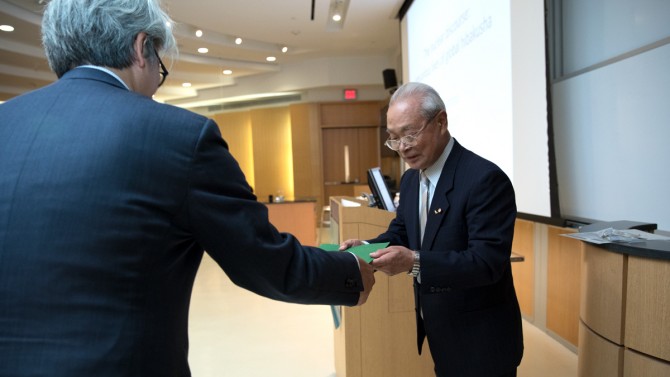Atomic bomb survivor calls for peace in interfaith series lecture
By Elizabeth Kelley
Toyokazu Ihara, a survivor of the United States’ 1945 atomic bombing of Nagasaki, Japan, has dedicated much of his life to promoting nuclear disarmament and peace initiatives around the world.
On Sept. 28, he was joined by Yuki Miyamoto, author of the book “Beyond the Mushroom Cloud: Commemoration, Religion, and Responsibility after Hiroshima,” as part of a series on interfaith dialogue sponsored by the Mario Einaudi Center for International Studies and Cornell United Religious Work.
The audience, which packed a lecture hall in the Physical Sciences Building, included a nine-person delegation from Nagasaki in addition to students, faculty and Ithaca residents.
Ihara was 9 years old at the time of the bombings. When the bombs were dropped, he was deep in the mountains, four miles from the hypocenter of the explosion, and was spared from the direct effects. His mother, sister and brothers, who assisted in rescue efforts, soon died of radiation poisoning.
In his talk, Ihara challenged common justifications for the bombings, including the ideas that the U.S. was retaliating for the Japanese bombing of Pearl Harbor or aimed to limit casualties on both sides by bringing a swift end to the war. “We suspect that in fact the bombing of Hiroshima and Nagasaki was an experiment into the destructive power of atomic bombs on cities and human lives, as well as an attempt to establish hegemony in the world,” he said.
Ihara spoke on behalf of “hibakusha” (nuclear bomb survivors) in opposition to all nuclear technology. He emphasized that this includes nuclear power plants and criticized the Japanese government’s commitment to nuclear power in the wake of the Fukushima Daiichi disaster of 2011, which has still not been contained, he said.
Ihara, a Buddhist, also spoke of his involvement in Nagasaki’s vibrant local peace movement with leaders from the city’s Catholic, Protestant, Shinto, and Muslim communities.
After Ihara spoke, Miyamoto provided “historical context” to better understand Ihara’s personal account. She said that most people think of the bombings of Hiroshima and Nagasaki as the only times nuclear weapons have been used, but the U.S. has detonated nuclear devices 1,032 times, most notably in the Marshall Islands, where 91 percent of residents suffered from blood disorder by the 1980s. The nuclear waste from these tests and the production of nuclear weapons on U.S. soil have produced lasting effects, she said. She echoed Ihara’s rejection of nuclear power, pointing out that North Korea does not need nuclear weaponry if it has missiles that can reach one of the dozens of nuclear power facilities on Japanese soil.
Ihara is in the U.S. as a “Special Communicator for a World without Nuclear Weapons,” a designation granted by the Japanese ministry of foreign affairs. As part of his presentation, he spoke about Mayors for Peace, an organization founded by the mayor of Nagasaki, for which he serves as vice chair. Ihara brought letters to Cornell President Martha E. Pollack and Ithaca Mayor Svante Myrick ’09, encouraging Cornell to promote the anti-nuclear movement in the scientific community and Ithaca to join Mayors for Peace.
He concluded his presentation, which was given in Japanese, with a call to action made in English: “Nagasaki must be the last.”
Elizabeth Kelley ’19 is a writer intern for the Cornell Chronicle.
Media Contact
Get Cornell news delivered right to your inbox.
Subscribe